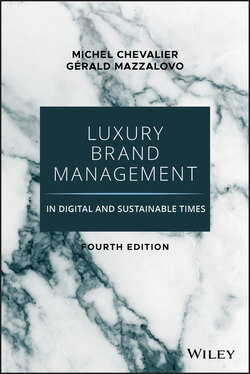Читать книгу Luxury Brand Management in Digital and Sustainable Times - Michel Chevalier - Страница 34
Product and Experience Luxuries
ОглавлениеSpecific trends are showing that some parts of the market have started to escape from the most traditional acceptance of luxury toward a more accessible, more experiential, and maybe more moral attitude toward it. In fact, we have been observing for more than 20 years the emergence of a luxury of experience in parallel to what we could call the luxury of products. Besides the ownership of products, such as watches, clothes, jewelry, accessories, fragrances, and beauty products, has grown the desire and therefore the markets for adventurous or luxury travel (Mont Blanc and Everest have never seen so many visitors), space trips, haute cuisine, spas, extraordinary shows (opera, concerts, sports events), and so on. The phenomenon goes beyond the emergence of new industries proposing luxury experiences like the ones we just liste, but also the experiences built around the products including physical environment, planned consumer path (pre- and post-purchase), associations to other themes than the product itself, and so on.
The change is not a banality as it has a lot of management implications for the brands that want to be competitive in this field and, frankly, none of the traditional luxury brands can afford not to consider this new dimension. After all, retail distribution always has had an experiential dimension, fragrances too. The advent of the Internet renders pre- and after-sales services even more important. Moreover, all service brands were already involved in experiential management. It is not a major discontinuity of the consumption process because, as we saw earlier in Figure 1.4., the product purchase has to do with the personal satisfaction of ownership but also with the experience of being socially involved in association with the products (“Have they seen me with my new Rolex?”). It is a shift at the microeconomic level with product brands paying more attention to the surrounding context in terms of place and time, and the purchase process of the products, as well as a shift at the macroeconomic level, with new industries and services defining a new kind of luxury.
Most of the managerial issues raised by experiential luxury are related to creation in general. How do you create these unforgettable, exceptional, intense moments in a better way than your competitors? Designing ambiances, atmospheres, and contexts is more complex and broad than just designing a product and often requires different skills. Event management, where ambiance, atmospheres, and contexts need to be created, is becoming crucial in the luxury field.
